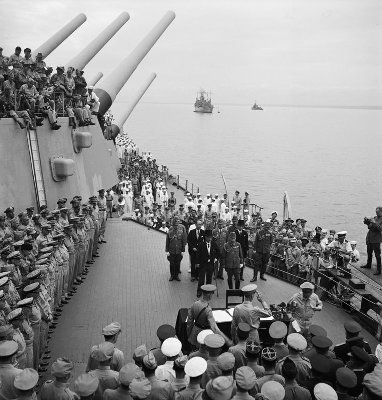



The four Iowa-class battleships built during WW II were the largest and fastest U.S. battleships ever built. Their 16 inch guns could hurl 2,700 pound shells 23 miles in 50 seconds with pinpoint accuracy. I have toured all of these ships: the USS Wisconsin in Norfolk, Virginia, the USS New Jersey in Camden, New Jersey, the USS Missouri in Pearl Harbor, Hawaii and the USS Iowa in Los Angeles, California.
The USS Missouri or “Mighty Mo” is the most famous of the Iowa-class battleships as it was on her deck on September 2, 1945 that the Japanese unconditionally surrendered ending World War II. There is a plaque on her deck that marks the spot of the signing of the instrument of surrender. You can also see a dent on her deck where a Kamikaze plane hit. The pilot’s body was found on the deck (the plane broke apart on impact but didn’t explode) and the captain of the Missouri was later criticized by some for giving the pilot a burial at sea with military honors.
In addition to World War II, the Missouri also saw action in the Korean War and Operation Desert Storm in the Persian Gulf earning eleven battle stars.
There were two other Iowa-class battleships being built during World War II – USS Illinois and USS Kentucky. Both were scrapped when World War II ended.
Facts and General Characteristics of the Ship:
Keel laid: January 6, 1941 at Brooklyn Navy Yard
Launched: January 29, 1944
Commissioned: June 11, 1944
Decommissioned: February 26, 1955
Recommissioned after extensive modernization and refurbishment: May 10, 1986
Decommissioned: March 31, 1992
Length: 887 feet
Height: 209 feet from keel to mast
Beam: 108 feet
Weight: 58,000 tons (full load); 45,000 tons (unloaded)
Hull armor thickness: 13.5 inches
Armament (before refurbishment): nine 16 inch guns, twenty 5 inch anti-aircraft guns, eighty 40 mm Bofors anti-aircraft guns and forty-nine 20 mm Oerlikin anti-aircraft guns.
Speed: In excess of 30 knots (35 mph)
Range: 9,600 miles @ 25 knots, 16,600 miles @ 15 knots
Complement (before refurbishment): 2,700 officers and men
The Model:
After I started building this model, I soon realized why I waited seven years after I purchased it and two years after I retired to build it. It was definitely the most difficult model I ever completed! Some parts were so small, I could barely hold them with tweezers or see them even with a magnifying lamp. I went cross-eyed and had to hunt for dropped parts on the floor more than a few times. I purchased a separate set of brass photoetched parts which are much more detailed than the plastic stock parts. Mainly, I wanted to add the rails which weren’t included with the model. I didn’t use all the photoetched parts but besides the railing, I used photoetched radars, antennas and the aircraft crane and catapults. Masking and painting the hull and adding the rigging were especially difficult. There are many details that aren’t obviously visible. I did a lot of extra work painting the vertical surfaces of all above deck structures a slightly different shade of gray than the deck and horizontal surfaces and that is only apparent in certain light. I built the oak base myself but had the lexan dust cover and name plate custom-made.
So was it all worth it? I found two companies online that sell completed 1/350 scale plastic USS Missouri models. One sells their version for $2,000 and the other’s price is based on the options you choose. While my version isn’t quite as “museum quality” as those models, I’m happy with the final results.
Facts and General Characteristics of the Model:
Manufacturer: Tamiya Inc., Japan
Scale: 1/350
Length: 30 inches
Height: 6.25 inches
Beam: 2.75 inches
Paint Scheme: Navy measure 22
Hours to build (model only): 112
To scroll through the 20 photos of the model and ship, click on the right "forward" button below the photo.